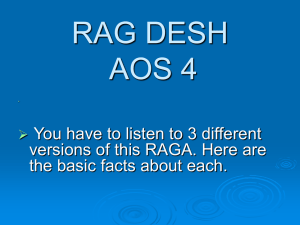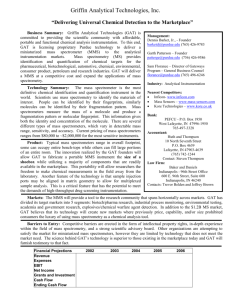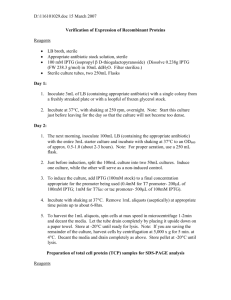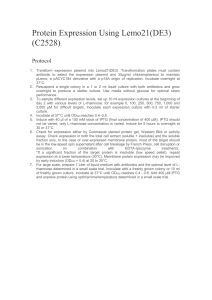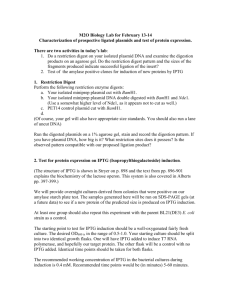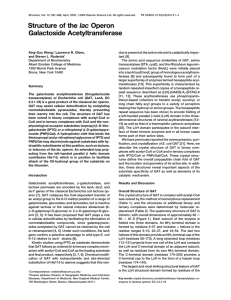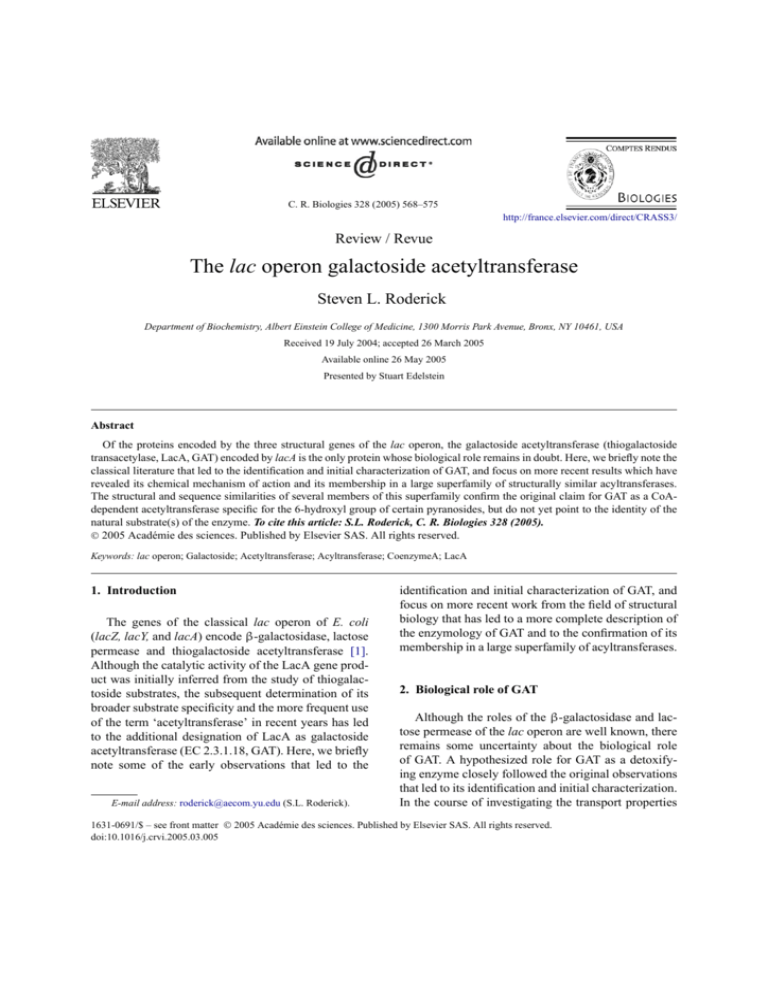
C. R. Biologies 328 (2005) 568–575
http://france.elsevier.com/direct/CRASS3/
Review / Revue
The lac operon galactoside acetyltransferase
Steven L. Roderick
Department of Biochemistry, Albert Einstein College of Medicine, 1300 Morris Park Avenue, Bronx, NY 10461, USA
Received 19 July 2004; accepted 26 March 2005
Available online 26 May 2005
Presented by Stuart Edelstein
Abstract
Of the proteins encoded by the three structural genes of the lac operon, the galactoside acetyltransferase (thiogalactoside
transacetylase, LacA, GAT) encoded by lacA is the only protein whose biological role remains in doubt. Here, we briefly note the
classical literature that led to the identification and initial characterization of GAT, and focus on more recent results which have
revealed its chemical mechanism of action and its membership in a large superfamily of structurally similar acyltransferases.
The structural and sequence similarities of several members of this superfamily confirm the original claim for GAT as a CoAdependent acetyltransferase specific for the 6-hydroxyl group of certain pyranosides, but do not yet point to the identity of the
natural substrate(s) of the enzyme. To cite this article: S.L. Roderick, C. R. Biologies 328 (2005).
2005 Académie des sciences. Published by Elsevier SAS. All rights reserved.
Keywords: lac operon; Galactoside; Acetyltransferase; Acyltransferase; CoenzymeA; LacA
1. Introduction
The genes of the classical lac operon of E. coli
(lacZ, lacY, and lacA) encode β-galactosidase, lactose
permease and thiogalactoside acetyltransferase [1].
Although the catalytic activity of the LacA gene product was initially inferred from the study of thiogalactoside substrates, the subsequent determination of its
broader substrate specificity and the more frequent use
of the term ‘acetyltransferase’ in recent years has led
to the additional designation of LacA as galactoside
acetyltransferase (EC 2.3.1.18, GAT). Here, we briefly
note some of the early observations that led to the
E-mail address: roderick@aecom.yu.edu (S.L. Roderick).
identification and initial characterization of GAT, and
focus on more recent work from the field of structural
biology that has led to a more complete description of
the enzymology of GAT and to the confirmation of its
membership in a large superfamily of acyltransferases.
2. Biological role of GAT
Although the roles of the β-galactosidase and lactose permease of the lac operon are well known, there
remains some uncertainty about the biological role
of GAT. A hypothesized role for GAT as a detoxifying enzyme closely followed the original observations
that led to its identification and initial characterization.
In the course of investigating the transport properties
1631-0691/$ – see front matter 2005 Académie des sciences. Published by Elsevier SAS. All rights reserved.
doi:10.1016/j.crvi.2005.03.005
S.L. Roderick / C. R. Biologies 328 (2005) 568–575
of methyl-1-thio-β-D-galactoside (TMG), Monod and
co-workers reported that about 5% of the extracted
intracellular substance was chemically modified [2].
This observation was subsequently extended to additional thiogalactosides, including isopropyl-1-thio-βD -galactoside (IPTG), with the identification of 6-Oacetyl-IPTG as the chemically altered compound [3].
This acetylated compound did not appear to revert to
the original galactoside and did not act as an inducer
of the lac operon or as a substrate of lactose permease.
This acetyl-CoA dependent acetyltransferase activity
was detected only in cell-free extracts obtained from
permease-containing strains [4] but did not seem to affect membrane transport [5,6].
Wilson and Kashket reported that E. coli lacA+
strains accumulated less radiolabeled TMG relative to
lacA− strains, due to acetylation of TMG, followed
by its efflux from the cell and a reduced rate of retransport of the acetylated compound [5]. The question
of whether such a mechanism could confer selective
advantage to lacA+ strains was examined by Andrews
and Lin [7], who measured the generation times of
E. coli lacA+ cultures grown on mixtures of metabolizable (lactose or lactulose) and non-metabolizable
(TMG or IPTG) substrates. Although IPTG affected
the generation times of lacA+ strains only marginally,
the growth rate of lacA− strains incapable of acetylating IPTG for discharge into the medium was significantly reduced. These results were extended to mixed
culture experiments in which a 15-fold enrichment of
lacA+ vs. lacA− cells was observed after 50 generations in the presence of hydrolyzable β-galactosides
and IPTG, demonstrating a selective advantage conferred by the lacA+ genotype under these conditions.
Taken together, these experiments led to the hypothesis that the lacA gene serves as a backup device to
avoid metabolic congestion, by a mechanism of acetylation, diffusion of the chemically altered compound
from the cell, and a diminished rate of retransport.
This strategy could allow cells to avoid metabolic
predicaments, such as for molecules that are incidentally transported by the broad specificity lactose permease, but which are either non-metabolizable or act
as gratuitous inducers. This hypothesis has no significant competition, but has yet to be supported by the
identification of any natural high affinity substrate for
the enzyme, although it has been argued that high K m
values for acceptor substrates could be of adaptive
569
significance if they enabled the cell to use energy to
acetylate compounds for discharge only when the levels of the acceptor substrate were high [7].
3. Kinetics and substrate specificity
The partial purification of GAT was first reported
in 1962, and permitted a confirmation of its activity
against a panel of galactosides as well as the identification of lactose, maltose, galactose and glucose as
poor substrates [8]. Subsequent high-level purification
of the enzyme led to its crystallization from solutions
of ammonium sulfate [9]. The introduction of Ellman’s reagent (dithiobis(2-nitrobenzoic acid), DTNB)
improved the sensitivity of the assay for GAT by about
100-fold [10], and remains the primary means for the
assay of GAT today.
The detailed kinetic mechanism of GAT was first
studied by Musso and Zabin and found to be consistent with a sequential ordered bi-bi addition pattern, with acetyl-CoA as the first substrate to associate
with the enzyme and CoA as the final product to depart [11]. Galactosides and, to a lesser extent, glucosides (epimers at C-4) were acceptors, but mannosides
were not – indicating that the epimeric configuration
of the C-2 glycosyl moiety that differentiates these
sugars is an important determinant for substrate recognition. These authors also confirmed that the enzyme
requires a thioglycoside or a hydrophobic aglycone for
activity, in agreement with previous results [8,10]. The
measured Km value for IPTG of 0.77 M based on concentrations of IPTG below those for which substrate
inhibition was observed (about 1.5 M) immediately
raised suspicion that additional structural features of
the biological acceptor for GAT had yet to be identified [11].
The pattern of substrate specificity has more recently been studied by Shaw and co-workers in the
course of a kinetic, mutagenic and spectroscopic
investigation [12]. This work identified PNPβGal
(p-nitrophenyl-β-D-galactopyranoside) as the best
substrate, with a Km value about 10-fold less than
IPTG (cf. 63.4 mM vs. 0.77 M). The similar Km and
k cat values for the PNPβGal and phenylβGal substrates suggested that the hydrophobic phenyl group
and not the p-nitro moiety of PNPβGal was the primary specificity determinant responsible for the lower
570
S.L. Roderick / C. R. Biologies 328 (2005) 568–575
K m values of phenyl galactosides relative to IPTG, a
molecule bearing an isopropyl aglycone.
4. Structure
4.1. Primary structure
The amino acid sequence of GAT was initially
determined by chemical methods [13] and later confirmed in the course of completing the DNA sequence
of the lac operon [14]. Based on the sequence of
the nodL gene of Rhizobium leguminosarum, Downie
detected significant sequence similarity between the
amino acid sequence of NodL and the acetyltransferases encoded by the cysE (serine acetyltransferase)
and lacA genes of E. coli [15]. NodL acetylates
the 6-hydroxyl position of the non-reducing terminal
sugar of a variety of lipo-oligosaccharides, chitin fragments and N -acetylglucosamine [16].
Further analysis of these and additional sequences
available several years later allowed two groups to
identify a previously unrecognized six residue repeated motif in the sequences of these proteins, as well
as several other acyltransferases. This repeating sequence theme was termed an ‘isoleucine patch’ [17]
or ‘hexapeptide repeat’ [18]. Imperfect copies of
this hexapeptide repeat motif, generally described
as [LIV]–[GAED]–X–X–[STAV]–X, have since been
found as an easily identifiable and characteristic feature of an expanding family of acyltransferases. These
hexapeptide acyltransferases catalyze the transfer of
acetyl, succinyl or R-3-hydroxy fatty acyl groups from
their corresponding thioesters to amino acids, sugars,
metabolic intermediates or natural product acceptors
bearing free hydroxyl or amine groups. These enzymes participate in the processes of cell wall biosynthesis, amino acid metabolism and detoxification and
are represented in all three kingdoms of life, but have
yet to be found in animals.
4.2. Overall three-dimensional structure
Although the crystallization of GAT from solutions
of ammonium sulfate was first reported by Zabin and
co-workers in 1963 [9], the production of crystals suitable for a three-dimensional structure determination
(also obtained from solutions of ammonium sulfate)
was described 36 years later [19]. These crystals led
to an X-ray crystallographic structure determination of
GAT in several complexes with substrates and products at resolutions ranging from 3.2 to 2.5 Å [20].
Crystallization of the GAT apoenzyme could not be reproduced to form crystals suitable for crystallographic
analysis, nor could back soaking of crystals prepared
in the presence of acetyl-CoA be used to yield crystals
that were free of cofactor. Hence, the structure of the
GAT apoenzyme remains unknown.
The overall structure of GAT is trimeric (Fig. 1)
[20]. Its appearance is dominated by a coiled structural
domain in the residue range 58–173 of the 203 residue
polypeptide that corresponds to its tandem-repeated
copies of hexapeptide repeats. This left-handed parallel β-helix (LβH) structural domain [21] is intimately
related to the active sites of all of the enzymes belonging to the hexapeptide acyltransferase superfamily of enzymes [20–27]. Although some reports have
suggested a weak amino acid sequence similarity between GAT and the classical CATIII chloramphenicol
acetyltransferase, their overall conformations are not
similar [20,28].
Each six-residue hexapeptide repeat is used to form
one side of a triangular coil with a canonical 18 residue
length (Fig. 2). Because each coil is composed of an
integral number of residues, they are spatially related
to one another by simple translations. The overall appearance of the LβH structural domain is that of an
equilateral prism, with each flat surface representing
a single untwisted parallel β-sheet [21]. The active
sites of these trimeric enzymes are invariably located
at the junction between two adjacent LβH domains
and frequently incorporate one or more polypeptide
loops that project from the vertices of their triangular coils. The LβH domain of GAT is composed of
approximately 5.3 coils and is interrupted by an extended loop (residues 112–131) (Fig. 2). This loop of
20 residues substitutes for a two residue turn and may
have arisen by an evolutionary mechanism by which
a single coil of the LβH was expelled from the coiled
domain, perhaps by mutation of a residue that violated
the hexapeptide repeat sequence rule.
4.3. Active-site structure and catalytic mechanism
The structure of GAT has been determined in binary complexes with CoA or acetyl-CoA, and in
S.L. Roderick / C. R. Biologies 328 (2005) 568–575
571
Fig. 1. Ribbon diagram of GAT bound to IPTG and CoA. Two IPTG and one CoA molecules are present in each of three active sites of the
trimeric enzyme. Left: Viewed perpendicular to the molecular threefold axis. Right: Viewed parallel to the threefold axis, emphasizing the
triangular LβH helical domains.
Fig. 2. The LβH domain and the hexapeptide repeat sequence motif. Left: Structure-based sequence alignment of the LβH domain of GAT.
Residues corresponding to six complete or partial coils (C1 to C6) are depicted as are the residues in this range that lack coiled conformation
(boxed), including the extended loop (residues 112–131). Each complete coil is composed of three flat β-sheets (PB1, PB2, PB3) separated
by three turns (T1, T2, T3). The residue types repeated within each coil are termed i, i + 1, . . . , i + 5 and corresponding to the canonical
hexapeptide sequence motif [LIV]–[GAED]–X–X-[STAV]–X, respectively. The most highly conserved residues at the i position are reverse
shaded. Right: Coil C4 of the LβH domain with labeled residue types. Residues at the i and i + 4 positions project into the lumen of the LβH.
Each side of the triangular coil corresponds to a single parallel β-strand.
ternary complexes with IPTG/CoA and PNPβGal/
CoA [20]. The GAT trimer contains three apparently
independent active sites, each receiving contributions
from two subunits, here termed A and B. The conformation of the cofactor resembles a fishhook. Its 3 phospho ADP moiety is located nearest the C-terminal
coils of the LβH and its pantetheinyl arm is directed
toward the NH2 -terminal coils (Fig. 1). The pantetheinyl arm of the cofactor accepts hydrogen bonds from
adjacent coils of the LβH, promoting its extended conformation.
The general location of the IPTG or PNPβGal acceptor substrates is near the CoA thiol or acetyl-CoA
thioester group and the galactosyl moieties of these ac-
572
S.L. Roderick / C. R. Biologies 328 (2005) 568–575
Fig. 3. Active-site structure of GAT bound to IPTG and CoA. Hydrophilic interactions are depicted by dotted line segments. The
proximal IPTG that participates as the acetyl acceptor is depicted
as is the additional distal IPTG molecule.
ceptors utilize a conserved pattern of interactions with
the enzyme (Fig. 3). The structure of GAT in complex with CoA and IPTG revealed two molecules of
IPTG per active site, separated by 8 Å. These molecules are termed proximal or distal, based on their distance to the cofactor thiol. The proximal IPTG forms
hydrogen bonds to the enzyme from each of its four
hydroxyl groups. The active site of GAT is similar
to that of the recently determined structure of E. coli
maltose acetyltransferase (MAT) [27]. The interaction
of the C-4 hydroxyl group of IPTG with Asp 93B
of GAT may confer substrate preference for galac-
tosides over glucosides, since the active site MAT,
which preferentially acetylates the 6-hydroxyl group
of glucosides, substitutes valine at this position, as
does the NodL acetyltransferase capable of acetylating glucose-derived N -acetylglucosamine [16].
The distal IPTG is too far from the cofactor to participate as a substrate. Although the concentration of
IPTG used to prepare the ternary complex crystals of
GAT with IPTG/CoA was high, 156 mM, the existence of the distal IPTG binding site might nonetheless
indicate the existence of an extended acceptor binding pocket that could accommodate larger substrates.
Whether this distal binding site is also related to the
observed phenomenon of kinetic substrate inhibition
is unknown.
The hydrophobic binding pocket responsible for
binding the aglycone moiety of the acceptor substrate is formed by Tyr 83A, Leu 103A and Met127B
(Fig. 4). A biologically important feature of this
pocket may be to discriminate against molecules that
are not to be acetylated – such as disaccharides and
glycosides that bear hydrophilic groups at the same
position as the hydrophobic aglycones of IPTG, TMG
or PNPβGal. Among the molecules that are poor
substrates of GAT are lactose (4-β-D-galactosyl-Dglucose) and two natural inducers of the lac operonallolactose (6-β-D-galactosyl-D-glucose) and the plant
product, 2-β-D-galactosyl-glycerol, all of which bear
hydrophilic substituents at this position.
GAT catalyzes the acetyl-CoA dependent acetylation of the 6-O-methyl position of a variety of pyranosides. The 6-hydroxyl group of the proximal IPTG
in the IPTG/CoA complex interacts with His 115B
Fig. 4. Superposition of GAT in complex with acetyl-CoA and IPTG (blue bonds). The residues referred to in the text are labeled. Subunits A
(yellow) and B (orange) are depicted.
S.L. Roderick / C. R. Biologies 328 (2005) 568–575
from the extended loop, Asn 85A, and the thiol group
of CoA. His 115 had been previously implicated in the
iodoacetamide inactivation of the enzyme and its replacement by alanine reduced k cat by 1800-fold [12].
His 115 and Asn 85 are also conserved in the sequences of MAT and NodL. In GAT, this histidine
donates a hydrogen bond to the peptide carbonyl oxygen of Glu 126B, which identifies its imidazole ND1
nitrogen as protonated and presumably increases the
basicity at NE2 (Figs. 4, 5). The distance between the
phenyl ring of PNPβGal or the isopropyl group of
IPTG to His 115 is only 4 Å, and so it remains possible that some molecules may bind at or near the active
site of the enzyme, but do so in such a manner as to
alter the orientation of this histidine residue to prevent
efficient catalysis.
The kinetic mechanism of GAT is best described
as sequential ordered bi-bi [11,12], consistent with
a chemical mechanism whereby the thioester group
of acetyl-CoA is attacked directly by the 6-hydroxyl
group of the substrate. This is supported by the crystal structure of GAT in complexes with acetyl-CoA
and IPTG/CoA (Fig. 4). A superposition of these
structures places the 6-hydroxyl group of the acceptor within 1.7 Å of the acetyl-CoA thioester carbonyl carbon atom, indicating that this hydroxyl group
may indeed be close enough for direct attack in an
SN 2 ternary complex mechanism. Taken together with
kinetic data and the structure of GAT in complex
with acetyl-CoA, a chemical mechanism of action can
be proposed in which His 115B acts to extract the
6-hydroxyl proton from the acceptor prior to or concomitant with attack of this group on the thioester.
The observed interaction of Asn 85A with the acetylCoA thioester oxygen may indicate that this side chain
plays a role in stabilizing the oxyanion intermediate.
His 115B may also function to donate a proton from
the NE2 position to the resulting CoA thiolate concomitant with or subsequent to the collapse of the
tetrahedral intermediate.
4.4. Relationships to other hexapeptide
acyltransferases
It is now well-established that GAT is a member
of the hexapeptide acyltransferase superfamily of enzymes bearing tandem-repeated copies of a six-residue
periodicity theme. These hexapeptide repeats encode
573
Fig. 5. The proposed SN 2 reaction mechanism of GAT derived from
kinetic and structural studies. His 115B functions to abstract a proton and perhaps to protonate the resulting thiolate. A tetrahedral
intermediate is formed by the attack of the IPTG 6-hydroxyl group
on the thioester carbonyl carbon acetyl-CoA and is stabilized by the
carboxamide group of Asn 85A.
folding of an unusual coiled LβH domain which is
intimately involved in the construction of the active
sites of these enzymes. However, the active sites of
these enzymes also accept contributions from portions
of the polypeptide chain external to the LβH and so
the detailed arrangements of active site residues differ significantly within this superfamily [20–27]. Of
574
S.L. Roderick / C. R. Biologies 328 (2005) 568–575
the hexapeptide acetyltransferases of known threedimensional structure, GAT is most similar to MAT,
with 42% amino acid sequence identity and an rms
deviation for 169 selected Cα coordinates of only
1.0 Å [27]. Although MAT does not belong to an obvious operon, its proposed role is also as a detoxification
agent, with preference for non-metabolizable glucosides bearing a hydrophobic aglycone [27,29]. The
best known substrate for MAT is isopropyl-1-thio-βD -glucoside (IPTGlu), the C-4 epimer of IPTG, with a
K m value of 17.2 mM [27]. In addition, the GAT, MAT
and NodL members of the hexapeptide acyltransferase
superfamily all acetylate the 6-hydroxyl group of hexose sugars and conserve His 115 and Asn 85 at their
active sites.
5. Conclusions
Recent structural characterization of GAT has revealed its overall three-dimensional structure, substrate binding modes and catalytic mechanism. Consideration of its amino acid sequence and the crystal structures of a variety of acyltransferases has
confirmed its placement in the hexapeptide acyltransferase superfamily of enzymes. The similarities
of its sequence, substrate specificity and active site
structure to MAT and NodL define a subgroup of
the hexapeptide acyltransferase superfamily whose
members transfer acetyl groups from acetyl-CoA to
the 6-hydroxyl group of hexose sugars, probably by
a common catalytic mechanism. A current gap in
knowledge exists for GAT as it is not known which
substrates the enzyme encounters in vivo. Until this
gap is filled, it is likely that some doubt will remain
concerning the biological role of this member of the
lac operon.
Acknowledgements
We thank Dr. Xing-Guo Wang for assistance and
helpful discussions. This work was supported by the
National Institutes of Health Grant AI-42154.
References
[1] F. Jacob, J. Monod, Genetic regulatory mechanisms in the synthesis of proteins, J. Mol. Biol. 3 (1961) 318–356.
[2] H.V. Rickenberg, G.N. Cohen, G. Buttin, J. Monod, La galactoside–perméase d’Escherichia coli, Ann. Inst. Pasteur 91
(1956) 829–857.
[3] L.A. Herzenberg, Isolation and identification of derivatives
formed in the course of intracellular accumulation of thiogalactosides by Escherichia coli, Arch. Biochem. Biophys. 93
(1961) 314–315.
[4] I. Zabin, A. Kepes, J. Monod, On the enzymic acetylation of isopropyl-β-D-thiogalactoside and its association with
galactoside-permease, Biochem. Biophys. Res. Commun. 1
(1959) 289–292.
[5] T.H. Wilson, E.R. Kashket, Isolation and properties of thiogalactoside transacetylase-negative mutants of Escherichia
coli, Biochim. Biophys. Acta 173 (1969) 501–508.
[6] C.F. Fox, J.R. Beckwith, W. Epstein, E.R. Signer, Transposition of the lac region of Escherichia coli. II. On the role of
thiogalactoside transacetylase in lactose metabolism, J. Mol.
Biol. 19 (1966) 576–579.
[7] K.J. Andrews, E.C.C. Lin, Thiogalactoside transacetylase of
the lactose operon as an enzyme for detoxification, J. Bacteriol. 128 (1976) 510–513.
[8] I. Zabin, A. Kepes, J. Monod, Thiogalactoside transacetylase,
J. Biol. Chem. 237 (1962) 253–257.
[9] I. Zabin, Crystalline thiogalactoside transacetylase, J. Biol.
Chem. 238 (1963) 3300–3306.
[10] D.H. Alpers, S.H. Appel, G.M. Tomkins, A spectrophotometric assay for thiogalactoside transacetylase, J. Biol. Chem. 240
(1965) 10–13.
[11] R.E. Musso, I. Zabin, Substrate specificity and kinetic studies on thiogalactoside transacetylase, Biochemistry 12 (1973)
553–557.
[12] A. Lewendon, J. Ellis, W.V. Shaw, Structural and mechanistic studies of galactoside acetyltransferase, the Escherichia coli LacA gene product, J. Biol. Chem. 270 (1995)
26326–26331.
[13] A.V. Fowler, M.A. Hediger, R.E. Musso, I. Zabin, The amino
acid sequence of thiogalactoside transacetylase of Escherichia
coli, Biochimie 67 (1985) 101–108.
[14] M.A. Hediger, D.F. Johnson, D.P. Nierlich, I. Zabin, DNA sequence of the lactose operon: The lacA gene and the transcriptional termination region, Proc. Natl Acad. Sci. USA 82 (1985)
6414–6418.
[15] J.A. Downie, The nodL gene from Rhizobium leguminosarum
is homologous to the acetyl transferases encoded by lacA and
cysE, Mol. Microbiol. 3 (1989) 1649–1651.
[16] G.V. Bloemberg, J.E. Thomas-Oates, B.J.J. Lugtenberg, H.P.
Spaink, Nodulation protein NodL of Rhizobium leguminosarum O-acetylates lipo-oligosaccharides, chitin fragments
and N -acetylglucosamine in vitro, Mol. Microbiol. 11 (1994)
793–804.
[17] I.B. Dicker, S. Seetharam, What is known about the structure
and function of the Escherichia coli protein FirA?, Mol. Microbiol. 6 (1992) 817–823.
[18] M. Vaara, Eight bacterial proteins, including UDP-N -acetylglucosamine acyltransferase (LpxA) and three other transferases of Escherichia coli, consist of a six-residue periodicity
theme, FEMS Microbiol. Lett. 97 (1992) 249–254.
S.L. Roderick / C. R. Biologies 328 (2005) 568–575
[19] X.-G. Wang, S.L. Roderick, Expression, purification, crystallization and preliminary X-ray data of Escherichia coli galactoside acetyltransferase, Acta Crystallogr. D 55 (1999) 1955–
1957.
[20] X.-G. Wang, L.R. Olsen, S.L. Roderick, Structure of the lac
Operon Galactoside Acetyltransferase, Structure 10 (2002)
581–588.
[21] C.R.H. Raetz, S.L. Roderick, A left-handed parallel β helix
in the structure of UDP-N -acetylglucosamine acyltransferase,
Science 270 (1995) 997–1000.
[22] T.W. Beaman, J.S. Blanchard, S.L. Roderick, The conformational change and active site structure of tetrahydrodipicolinate
N -succinyltransferase, Biochemistry 37 (1998) 10363–10369.
[23] T.W. Beaman, M. Sugantino, S.L. Roderick, Structure of the
hexapeptide xenobiotic acetyltransferase from Pseudomonas
aeruginosa, Biochemistry 37 (1998) 6689–6696.
[24] L.R. Olsen, S.L. Roderick, Structure of the Escherichia coli
[25]
[26]
[27]
[28]
[29]
575
GlmU pyrophosphorylase and acetyltransferase active sites,
Biochemistry 40 (2001) 1913–1921.
M. Sugantino, S.L. Roderick, Crystal Structure of Vat(D): An
acetyltransferase that inactivates streptogramin group A antibiotics, Biochemistry 41 (2002) 2209–2216.
L.R. Olsen, B. Huang, M.W. Vetting, S.L. Roderick, Structure
of serine acetyltransferase in complexes with CoA and its cysteine feedback inhibitor, Biochemistry 43 (2004) 6013–6019.
L. Lo Leggio, F. Dal Degan, P. Poulsen, S.M. Andersen, S. Larsen, The structure and specificity of Escherichia coli maltose
acetyltransferase give new insight into the LacA family of acyltransferases, Biochemistry 42 (2003) 5225–5235.
A.G.W. Leslie, P.C.E. Moody, W.V. Shaw, Structure of chloramphenicol acetyltransferase at 1.75-Å resolution, Proc. Natl
Acad. Sci. USA 85 (1988) 4133–4137.
B. Brand, W. Boos, Maltose Transacetylase of Escherichia
coli, J. Biol. Chem. 266 (1991) 14113–14118.

